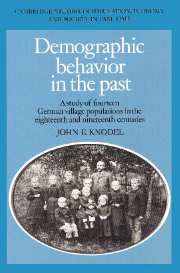 Demographic Behavior in the Past
Demographic Behavior in the Past Book contents
- Frontmatter
- Contents
- List of tables
- List of figures
- Acknowledgements
- PART I INTRODUCTION
- PART II MORTALITY
- PART III FAMILY FORMATION
- PART IV MARITAL REPRODUCTION
- 10 Trends in marital fertility and underlying natural fertility components
- 11 From natural fertility to family limitation
- 12 Starting, stopping, spacing and the fertility transition
- PART V INTERRELATIONSHIPS IN DEMOGRAPHIC BEHAVIOR
- PART VI CONCLUSION
- Appendices
- Bibliography
- Index
11 - From natural fertility to family limitation
Published online by Cambridge University Press: 04 August 2010
- Frontmatter
- Contents
- List of tables
- List of figures
- Acknowledgements
- PART I INTRODUCTION
- PART II MORTALITY
- PART III FAMILY FORMATION
- PART IV MARITAL REPRODUCTION
- 10 Trends in marital fertility and underlying natural fertility components
- 11 From natural fertility to family limitation
- 12 Starting, stopping, spacing and the fertility transition
- PART V INTERRELATIONSHIPS IN DEMOGRAPHIC BEHAVIOR
- PART VI CONCLUSION
- Appendices
- Bibliography
- Index
Summary
The decline in fertility associated with the demographic transition has been characterized as a shift from a system in which reproduction was largely controlled through social institutions and customs to a system where the private choice of individual couples plays the major role. This shift of control from the societal to the family level involves the emergence and spread of a fundamentally new pattern of reproductive behavior that has been described in the previous chapter as family limitation. In brief, the fertility transition can be viewed as representing the transformation of a population's reproductive pattern from one characterized by natural fertility to one in which family limitation predominates. In this chapter, the nature and extent of marital fertility control in the sample village populations are explored, in the course of which several relevant methodological and substantive issues are addressed.
As described in the previous chapter, at the core of family limitation are attempts to stop childbearing prior to the end of the biologically defined reproductive span. This has implications for both the age at which women terminate childbearing and the age patterns of fertility. The exploration of the shift of natural fertility to family limitation begins by examining indices that utilize these implications for detecting deliberate marital fertility control. In particular, the Coale–Trussell index of fertility control (m) and the age of mothers at last birth are examined in some detail.
- Type
- Chapter
- Information
- Demographic Behavior in the PastA Study of Fourteen German Village Populations in the Eighteenth and Nineteenth Centuries, pp. 287 - 317Publisher: Cambridge University PressPrint publication year: 1988


